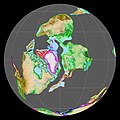Laurasia
Laurasia [1][2] was a supercontinent. It had been the northern part of the Pangaea global supercontinent. Pangaea split into Laurasia and Gondwana to the south during the Jurassic period.
Laurasia included most of the landmasses which make up today's continents of the northern hemisphere, chiefly Laurentia (the name given to the North American craton), Europe, Scandinavia, western Russia, Siberia, Kazakhstan, and China.[3]
Laurasia's name combines the names of Laurentia and Eurasia.
Although Laurasia is known as a Mesozoic phenomenon, today it is believed that the same continents that formed Laurasia also existed as a coherent continent after the breakup of Rodinia around 1 billion years ago. To avoid confusion with Laurasia, that continent is referred to as Proto-Laurasia.
Laurasia Media
Notes
- ↑ pronounced /lɔːˈreɪʒə/, how to say: /lɔːˈreɪʃiə/
- ↑ OED
- ↑ These names refer to continental plates rather than countries. The list has been simplified.




